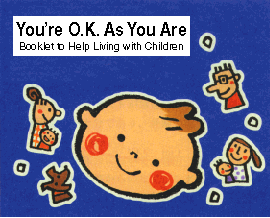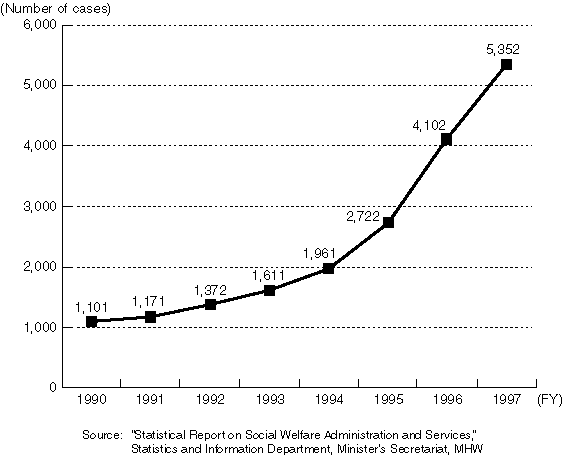Index /
Back /
Next
Section 3. Promotion of Measures for Sound Development of Children
1. Sound Development of Children
At the meeting of Central Child Welfare Council in July 1998, some people argued that to secure "comfortable places" for children at home and in the community would be effective for preventing delinquencies and promoting sound development of children. This view was presented as one of "the views upon sound development of children in the future".
Reflecting this view, large children centers which junior high and high school students can use are being constructed in fiscal 1999, while long-hour services at after-school children's clubs for children whose parents are not at home during the daytime on business, etc. are promoted. In addition, projects to open corporate welfare facilities to the public are under way. Thus, efforts are being made for securing comfortable places for children and young people.
Column
Booklet to Support Child Rearing
An increasing number of parents are concerned about child rearing. In light of this, the Ministry of Health and Welfare prepared and distributed six million copies of "You're O.K. As You Are" to parents, etc. who had infants and small children. The booklet has been designed to alleviate the worry in child rearing of the parents, encourage parents, and support them so that they can bring up their children with confidence.The booklet has been written in picture-book like form and tone.

|
2. Improvement of Measures to Support Independence of Children
Circumstances around children have changed drastically, as shown by a further decrease in the number of children and weaker child-rearing functions fulfilled by families and communities. Amid such changes, the forms of problems, including those of child abuse, have become more diversified and complicated.
Because of this, the purposes and functions of respective institutions were revised as part of the 1997 amendment to the Child Welfare Law. The revision was based upon the idea that children who needed protection should be given not only protection at an institution but also support to enable them to learn to live vigorously and displaying their characteristics as independent members of the society. In fiscal 1998, six support centers for children and families were founded, as new child welfare facilities to provide children at home and families with carefully planned consultation and support that suit the actualities of respective communities. In the meantime, seventeen projects for supporting independent living of children, which have been approved as legal projects, are under way as of March 1999. Thus, efforts are being made in accordance with the purport of the amendment.
3. Child Abuse
Child abuse, which includes physical and sexual violence, negligence or refusal of rearing, and mental abuse, gives unforeseeable effects upon the mental and physical states of children.
The number of consultation cases accepted at child guidance centers, which stood at 1,101 in fiscal 1990, increased to 5,352 in fiscal 1997, causing a serious social problem. The factors behind the rapid increase in the number of consultation cases include the urbanization and a increase in nuclear families in recent years, resulting in weaker child rearing functions played by families and communities. Such situations seem to have caused an increase in the number of parents who are worried about their child rearing and consider child rearing as a burden.
As for child abuse problems, preventive measures, early detection and early execution of countermeasures are important. It is necessary to develop regional networks, enhancing cooperation among child protection centers, support centers for children and families, health centers, schools, hospitals, police offices, volunteer groups, etc. under the leadership of child guidance centers. In addition, efforts are being made for promoting enlightenment activities to support child rearing at home and help early detection and preventing child abuse, through the preparation of guidebooks to help child guidance centers, etc. taking appropriate measures.
Figure 5-3-1. Changes in the Number of Counseling Cases against Child Abuse

It has been agreed that in fiscal 1999, efforts should be made for making regional residents pay keener attention to the prevention of child abuse, as well as for the establishment of foundation on which chief child welfare volunteers working in respective communities can actively take measures against child abuse and the improvement of the system to take care of the mental health of abused children.
4. Improvement of Measures for Fatherless Families
The measures for fatherless families taken in fiscal 1998 include 1 the expansion of financial resources for mother and widow welfare loans as well as the exemption of interests upon such loans, and a significant raising of the ceiling of school loan, 2 the expansion and improvement of training for home helpers who provide home-visit care, 3 the expansion of application of the special consultation project to motherless families and 4 the introduction of the employment promotion and support program aiming to establish a comprehensive employment support system through forming a fatherless family employment support program and enhancing cooperation among related organizations.
As for child rearing allowance, the income limit for receiving the allowance was revised in August 1998, in consideration of drastic changes around the system including a rapid increase in divorced fatherless families and for maintaining balance with low-income general households. At the same time, conditions for the payment of allowance were revised to enable recipients to continue receiving the allowance even after the recognition of the child by the father.
5. Countermeasures against Problems in Maternal and Child Health
(1) Coping with medical technology for reproduction and prenatal diagnosis
Medical technology for reproduction, including artificial insemination and in vitro fertilization, has shown a marked progress in recent years and become popular among people troubled with sterility. In Japan, the application of such technology has been restricted by the voluntary restraints by doctors, mainly the Association of Obstetricians and Gynecologists of Japan. In the meantime, legal problems have surfaced recently, concerning not only the safety of the technology but also morals and relationships between parents and children. Such problems include trading of sperm by private companies and the execution of in vitro fertilization between non spouses.
As for prenatal diagnosis to diagnose conditions of babies including disorders before birth, marker tests of mother serums, or blood tests conducted on pregnant women to check the possibility of disorders of fetuses, have rapidly diffused in recent years. Some experts have point out, however, that in some problematic cases, sufficient explanation is not given to the relevant woman for obtaining her complete consent before the test, causing confusions among pregnant women.
Under such circumstances, the Medical Technology Assessment Subcommittee for Advanced Medical Care of the Health Science Council has continued discussions upon problems around medical technology for reproduction since July 1997, based upon hearings from related organizations, etc. In order to make further discussions upon these problems, "Special Committee on Medical Technology for Reproduction" and "Special Committee on Prenatal Diagnosis" have held meetings since October 1998.
(2) Countermeasures against Sudden Infant Death Syndrome, etc.
An infant or small child who dies from Sudden Infant Death Syndrome (SIDS) dies suddenly while asleep, without any previous signs or illnesses. The number of infants and small children dying of the disease is about 500 every year, ranking as high as third among causes for deaths of infants and small children. The causes are unknown. Some researches have shown, however, that the risk of the outbreak of the disease is made higher by environmental factors of children, such as sleeping on their faces, parents' smoking, and non-maternal feeding.
In response to this, "Discussion Meeting on Countermeasures against SIDS" was held in June 1998, where discussions were made upon methods to prevent SIDS, etc. Based upon the discussions results, we have agreed to strive for enlightenment activities and diffuse knowledge among not only medical professionals and people engaged in nursery care but also the general public. Accordingly, information is being offered through Maternal and Child Health Handbooks, posters, and pamphlets.
In the meantime, the number of small children aged one to four dying of unexpected accidents (422 cases), such as drowning, suffocation, and traffic accidents, accounts for 24.8% of the total number of deaths of children in the same age category of 1,700, ranking first among death causes for such children. The prevention of such unexpected accidents upon infants and small children are shown in the Maternal and Child Health Handbooks. Attention is called also in mother's classes, after medical checks, etc.
Index /
Back /
Next

